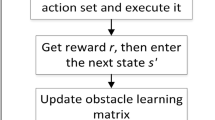Abstract
Using mobile robots in disaster areas can reduce risks and the search time in urban search and rescue operations. Optimal path-planning for mobile robotics can play a key role in the reduction of the search time for rescuing victims. In order to minimize the search time, the shortest path to the target should be determined. In this paper, a new integrated Reinforcement Learning—based method is proposed to search and find a hidden target in an unknown environment in the minimum time. The proposed algorithm is developed in two main phases. Depending on whether or not the mobile robot receives the signal from the hidden target, phases I or II of the proposed algorithm can be carried out. Then, the proposed algorithm is implemented on an e-puck robot in an urban environment which is simulated within Webots software. Finally, to demonstrate the efficiency of the proposed method and to verify it, the computational results from the proposed method are compared with three conventional methods from the literature.
















Similar content being viewed by others
References
Casper J, Murphy RR (2003) Human-robot interactions during the robot-assisted urban search and rescue response at the World Trade Center. IEEE Trans Syst Man Cybern Part B (Cybern) 33:367–385. https://doi.org/10.1109/TSMCB.2003.811794
Cormen TH, Stein C, Rivest RL, Leiserson CE (2001) Introduction to algorithms. McGraw-Hill Higher Education, New York
Faigl J, Macák J, Multi-Goal (2011) Path planning using self-organizing map with navigation functions. In: Proceedings of 19th European symposium on artificial neural networks, Bruges, Belgium, April 27–29
Fakoor M, Kosari A, Jafarzadeh M (2015) Revision on fuzzy artificial potential field for humanoid robot path planning in unknown environment. Int J Adv Mechatron Syst 6:174–183. https://doi.org/10.1504/IJAMECHS.2015.072707
Felner A (2011) Position paper: Dijkstra’s algorithm versus uniform cost search or a case against Dijkstra’s algorithm. In: Fourth annual symposium on combinatorial search
Geng N, Gong DW, Zhang Y (2014) PSO-based robot path planning for multisurvivor rescue in limited survival. Time Math Probl Eng 2014:10. https://doi.org/10.1155/2014/187370
Jafarzadeh H, Gholami S, Bashirzadeh R (2014) A new effective algorithm for on-line robot motion planning. Decis Sci Lett 3:121–130
Khanmohammadi S, Zarrin RS (2011) Intelligent path planning for rescue robot. In: Proceedings of world academy of science, engineering and technology. pp 764–769
Lee L (2015) Robotic search & rescue via online multi-task reinforcement learning. arXiv:1511.08967
Lodeiro-Santiago M, Santos-González I, Caballero-Gil P, Caballero-Gil C (2017) Secure system based on UAV and BLE for improving SAR missions. J Ambient Intell Humaniz Comput. https://doi.org/10.1007/s12652-017-0603-4
Majumder S, Kar S (2017) Multi-criteria shortest path for rough graph. J Ambient Intell Humaniz Comput. https://doi.org/10.1007/s12652-017-0601-6
Mehlhorn K, Sanders P (2008) Algorithms and data structures: the basic toolbox. Springer, Berlin, Heidelberg
Mondada F et al. (2009) The e-puck, a robot designed for education in engineering. In: Proceedings of the 9th conference on autonomous robot systems and competitions. vol LIS-CONF-2009-004. IPCB, Castelo Branco. pp 59–65
Pascarella D, Venticinque S, Aversa R, Mattei M, Blasi L (2015) Parallel and distributed computing for UAVs trajectory planning. J Ambient Intell Humaniz Comput 6:773–782. https://doi.org/10.1007/s12652-015-0282-y
Sutton RS, Barto AG (1998) Reinforcement learning: an introduction. Bradford Book. The MIT Press, Cambridge, MA
Williams RL, Wu J (2010) Dynamic obstacle avoidance for an omnidirectional mobile robot. J Robot. https://doi.org/10.1155/2010/901365
Yamauchi B (1998) Frontier-based exploration using multiple robots. In: Proceedings of the second international conference on Autonomous agents. ACM, pp 47–53
Zeng W, Church RL (2009) Finding shortest paths on real road networks: the case for A*. Int J Geogr Inf Sci 23:531–543. https://doi.org/10.1080/13658810801949850
Author information
Authors and Affiliations
Corresponding author
Rights and permissions
About this article
Cite this article
Sombolestan, S.M., Rasooli, A. & Khodaygan, S. Optimal path-planning for mobile robots to find a hidden target in an unknown environment based on machine learning. J Ambient Intell Human Comput 10, 1841–1850 (2019). https://doi.org/10.1007/s12652-018-0777-4
Received:
Accepted:
Published:
Issue Date:
DOI: https://doi.org/10.1007/s12652-018-0777-4




